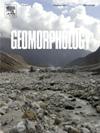金川黄土-古土壤序列的新发光年代学及其对青藏高原风沙沉积过程的意义
IF 3.1
2区 地球科学
Q2 GEOGRAPHY, PHYSICAL
引用次数: 0
摘要
青藏高原风成黄土沉积是记录高原干旱化和过去环境变化的重要档案。然而,由于缺乏对青藏高原黄土序列的详细年代学控制,阻碍了对青藏高原风成过程、干旱历史及其对全球气候变化的响应的更全面的认识。本研究以青藏高原东部金川地区保存完好的黄土-古土壤序列为研究对象,采用单次再生剂量(SAR)光激发发光(OSL)和后红外红外激发发光(pIRIR)技术建立了可靠的年表,阐明了青藏高原黄土景观的沙尘历史和发展。结果表明,石英SAR OSL定年可提供~50 ka的可靠年龄,而pIR200IR290协议将金川黄土层序的年龄控制扩展到~160 ka。新建立的跨越末次间冰期的金川黄土数值年代学揭示了显著的冰期-间冰期沙尘活动波动,表现为冰期沙尘积累增加,间冰期沙尘积累减少。综合OSL年龄、外推沙尘累积率、S1-S5古土壤特征以及磁化率曲线与海洋同位素阶段记录的相关性,我们估计MC黄土-古土壤序列的基本年龄超过约620 ka。这表明中更新世以来青藏高原发育了干旱环境和广泛的风成黄土景观。全球气候变化是影响该地区地貌发育和沙尘堆积历史的主要因素。本文章由计算机程序翻译,如有差异,请以英文原文为准。
New luminescence chronology of a loess-paleosol sequence at Jinchuan and its implications for aeolian deposition processes in the Tibetan Plateau
Aeolian loess deposits in the Tibetan Plateau (TP) are critical archives for documenting the plateau's aridification and past environmental changes. However, the lack of detailed chronological control over the TP loess sequences has hindered a more comprehensive understanding of aeolian processes, the TP's arid history, and its response to global climate change. This study investigates a well-preserved loess-paleosol sequence at Jinchuan in the eastern TP, employing single-aliquot regenerative-dose (SAR) optically stimulated luminescence (OSL) and post-infrared infrared stimulated luminescence (pIRIR) protocols to establish a robust chronology and elucidate the dust history and development of loess landscapes in the TP. Our results demonstrate that quartz SAR OSL dating provides reliable ages up to ~50 ka, while the pIR200IR290 protocol extends age control to ~160 ka for the Jinchuan loess sequence. The newly established numerical chronology for the Jinchuan loess, spanning the Last Interglacial, reveals significant glacial-interglacial fluctuations in dust activity, characterized by increased dust accumulation during glacial periods and decreased accumulation during interglacial periods on the TP. By integrating OSL ages, extrapolated dust accumulation rates, identified S1–S5 paleosols, and correlations between magnetic susceptibility curves and marine isotope stage records, we estimate the basal age of the MC loess-paleosol sequence to exceed approximately 620 ka. This suggests that an arid environment and extensive aeolian loess landscapes have developed on the TP since the mid-Pleistocene. Global climate change has served as the primary driver in shaping the geomorphic development and dust accumulation history of this region.
求助全文
通过发布文献求助,成功后即可免费获取论文全文。
去求助
来源期刊

Geomorphology
地学-地球科学综合
CiteScore
8.00
自引率
10.30%
发文量
309
审稿时长
3.4 months
期刊介绍:
Our journal''s scope includes geomorphic themes of: tectonics and regional structure; glacial processes and landforms; fluvial sequences, Quaternary environmental change and dating; fluvial processes and landforms; mass movement, slopes and periglacial processes; hillslopes and soil erosion; weathering, karst and soils; aeolian processes and landforms, coastal dunes and arid environments; coastal and marine processes, estuaries and lakes; modelling, theoretical and quantitative geomorphology; DEM, GIS and remote sensing methods and applications; hazards, applied and planetary geomorphology; and volcanics.
 求助内容:
求助内容: 应助结果提醒方式:
应助结果提醒方式:


